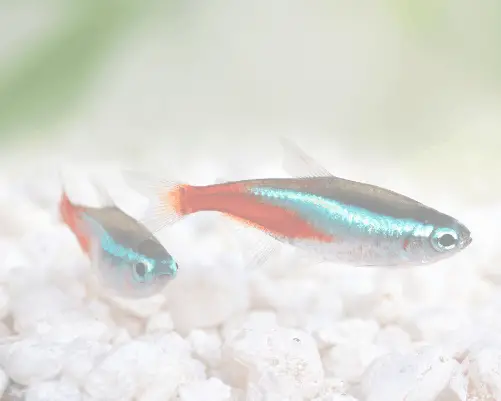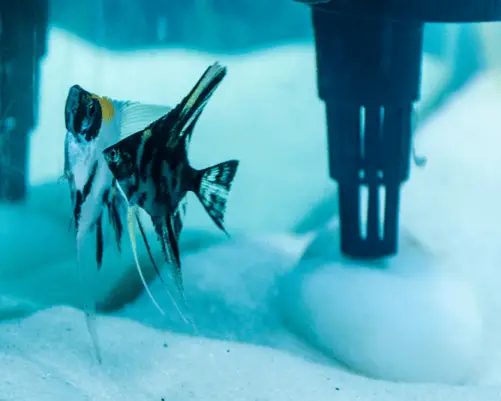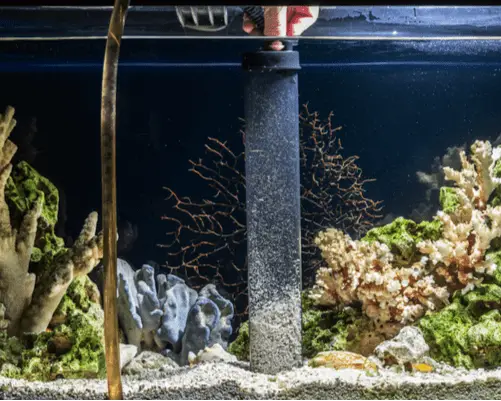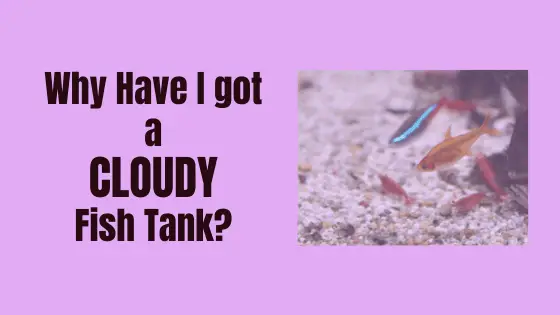Cloudy fish tank water is something we have all gone through at some point.

Thankfully, it’s not a cause for concern in most cases, but it is something that needs to be dealt with so as not to start causing a problem down the line.
Reasons for a cloudy fish tank falls into 2 areas-whether you have a new tank or an established tank.

Cloudy Water in a New Fish Tank.
Gravel and/or ornaments in your tank.
The most common reason why a brand new tank has cloudy water is because of the gravel substrate.
You need to thoroughly rinse the gravel before adding it to your tank. The gravel has a layer of dust particles on it which needs to be completely removed first.
To clean my gravel, I put a few handfuls into a sieve I had bought especially for cleaning, and rinsed it under warm water for a few minutes. I made sure I swished it around with my hands to ensure all of the gravel was being rinsed. I then put the clean gravel into my fish use only bucket and repeated the process until all of the gravel had been rinsed.
If you have only just filled the tank with water, the best, and quickest thing to do is to drain the tank and start again, making sure the gravel is completely cleaned.
If doing this, you will need to clean the inside of the tank as well so there are no traces of gravel dust.
The same principle goes for any ornaments you are adding to your tank. They need to be cleaned with warm water before being put in. You should not be using any form of cleaner, just warm water.
Adding untreated tap water to your tank.
This is something that not everyone new to this hobby may realise.
Our tap water is treated with chlorine so that it is safe for us to drink.
Unfortunately, the chlorine is highly toxic to fish so it must be treated before being added to your tank.
This will be a very good reason why goldfish don’t last very long when brought home from fairs etc (thankfully, this is quite rare now). They are usually in tap water which then kills them.
You need to buy Aquarium water conditioner like this one that I use.
This will remove the chlorine in your tap water, making it safe for your fish.
You don’t need to treat the water when you are rinsing your gravel or any ornaments, just when you are adding any amount of water into the tank.
Bacterial Bloom.
If your tank is at least a few days old and your water has started to go cloudy, this will be what is known as Bacterial Bloom and is nothing to worry about.
Bacterial Bloom (also known as Bacterial Blossom) is very common in a new tank.
It happens when microscopic bacterial organisms try to start establishing themselves in the tank.
As your tank is only just starting out, there hasn’t been much time for the good bacteria to start forming in the filter, so in the meantime, these tiny organisms multiply at a ridiculous rate, which is what the cloudy water is. They aren’t dangerous, just annoying.
If you are cycling your tank properly before adding fish, then you don’t need to take any action. As the good bacteria starts to form in the filter and multiply, nature will take over and the good bacteria will outnumber the annoying bacteria which will then die out. The cloudy water in this scenario should clear within a few days.
Testing your water at this stage, if you have recently started a cycle, will show ammonia. This is to be expected though as you need ammonia to start the nitrites off, which will then in turn start the nitrates off. This is all perfectly safe while there are no fish in the tank.
No matter how strong the urge is, don’t start changing the water! If you do that, you will go back to square one in the cycling process, and you will probably see the cloudy water again in a few days time.

Cloudy Water in an Established Fish Tank.
There are a number of reasons why water in an established tank can start to go cloudy.
Overstocking the tank.
Putting too many fish into your tank is a very bad idea.
It might seem, at first, like the fish have loads of room, but they grow bigger. This is why, when calculating how many fish you can put in your tank you calculate it based on their adult size.
The general rule of thumb is that you allow 1cm of adult sized fish (not including the tail or fins) for each litre of water.
If you overstock your tank, a number of things can happen.
Firstly, your fish will get stressed as they don’t have enough room. This can then lead to bullying and/or aggression between your fish.
More fish equals more waste. Excess waste will mean that the tiny microbes will have something to feed off as the filter won’t be able to keep up. Excess waste can also cause ammonia and nitrites to form in your tank.
This can be quite difficult to remedy permanently as you already have the fish.
You will need to make more regular water changes, and maybe try adding more plants.
If you are able to add as stronger filter system, you should definitely do so.
Overfeeding your fish.
This is very easily done, especially if you are new to the hobby.
You should only feed your fish a small amount. The size of a fish’s stomach is approximately the same size as it’s eye! It is safest to feed your fish the amount that they will consume in 2 to 3 minutes. They will then only get a chance to eat what they actually need rather than eating too much and then developing digestive problems.
Any food that isn’t eaten will start to decompose, which gives the annoying bacteria something to feast on, which then makes them multiply, hence the cloudy water.
If you think overfeeding is the reason for your water turning cloudy, carry out a partial water change, vacuum your gravel and then don’t feed them for 24 hours and see if it has cleared up.
Many aquarists suggest not feeding your fish one day a week which helps with their digestive system, and is much better for their health than overfeeding.
Wrong sized filter for your tank.
You should not have this problem if you have bought a fish tank with an internal filter provided as it will be the correct size for it.
If your tank doesn’t have a filter and you need to buy one, please check what size tank the filter is for. You are best going too big rather than too small. Although, saying that, don’t pick one too large that it completely overwhelms your tank.
If you have a large tank, try using 2 filters to help keep the water safe for your fish.
Cleaning your filter too much.
Your fish tank filter is probably the most important part of your tank.
The sponge part of the filter may look filthy but it is the life support system for your fish as this is where the good bacteria is formed, which helps to keep your fish healthy and happy.
You should be regularly checking your filter as a whole for any blockages that can be removed to help the water flow through easily, especially the inlet (where the water goes in to go up the tube).

I clean my filter sponge (also known as the filter media) once a month.
I am using the word ‘clean’ loosely here as what I do is submerge the sponge into a jug of the tank water and squeeze it very gently to try and get any large bits of gunk off, then I put it back into the filter.
Do not rinse, or even worse, clean, the filter sponge in normal tap water! You do not want a clean filter sponge as that is where all the good bacteria is. If you clean the sponge you are starting your tank cycle off again from day one. This will not be good for your fish at all and will be why your water has gone cloudy, as it’s Bacterial Bloom starting over.
Recent water change.
Hopefully, you will be carrying out regular partial water changes as part of your tank maintenance.
Regular partial (between 10-30% depending on who you listen to) water changes helps to keep your fish stress free and hopefully healthy for a long time to come.
The reason why you don’t change more of the water than this is because it will mess up your good bacteria levels. If you change a larger amount of your water, you risk getting rid of too much of the good bacteria and that means the whole cycling process starts again. This could result in the cloudy Bacterial Bloom appearing.
This is not great for your fish and can be very stressful, if not dangerous for them.
Gravel issues…again.

There are 2 main issues that can arise in an established tank where your gravel can be contributing to cloudy water.
The first is if you aren’t cleaning your gravel regularly.
It is amazing the amount of waste and uneaten food that will slip through the gravel and needs to be removed before turning nasty.
This will become an obvious problem if you have issue number 2, which is if you have fish that like to dig in the gravel!
They will do this for a few reasons-they could be making a pit to lay eggs, digging around looking for food, or just messing around-some Cichlids like to move the fixtures and fittings around on a regular basis.
Anything waste related that is disturbed by movement in the gravel will cause the water to turn cloudy.
You should aim to vacuum your gravel at least once every other week, or once a week is even better.
A dead fish in your tank.
I promised myself when I started my most recent tank, that I would take a fishy register every day to make sure everyone was accounted for.
This is so much easier said than done as the little buggers don’t make it easy, do they?
It is important to try and keep a count of the fish as if one of them has passed away, they need to be removed from the tank immediately.
It won’t always be very obvious for you to spot them either, especially if they are behind a plant or an ornament and are only very small.
Their corpses decay very quickly which can cause havoc in a tank if not spotted in time. As the body starts to decompose, the water will turn cloudy, but this can be dangerous, especially if the fish has died due to a disease.
Once you have removed the dead fish, test the water and also carry out a partial water change to help with the cloudiness.
I would test the water daily for the next 3 days to make sure everything is ok.
Conclusion.
Cloudy water in your fish tank does not mean that your fish are all about to die.
It is an indication that something is happening within your tank.
The best thing to do is not panic, and to go through a process of elimination to work out what is causing it, and if action needs to be taken, then do so.
Related Articles:
Can you use a magic eraser on a fish tank?



